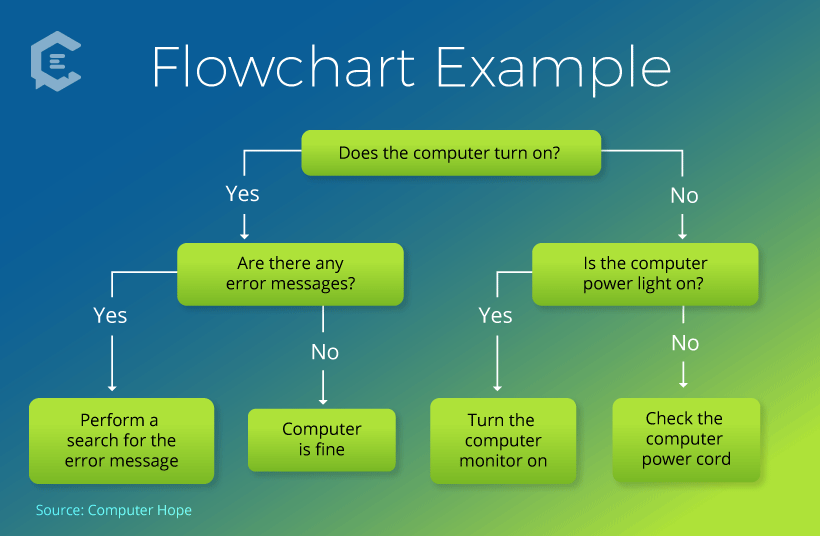If you were a child of the ’80s, you likely remember the ‘Choose Your Own Adventure’ book series, where you would be presented with different situations as you read. In the book, you became the character, and decisions you made determined the outcome of the story. If you were a knight trying to save the princess from the evil dragon, you may have found yourself hiking through an enchanted forest. When you came upon a pub you would need to decide if you were going to go in for a break or keep searching for the dragon’s lair. For each choice you would flip to a different page in the book, sometimes facing a painful death, and other times proceeding with the story.
Writing for a chatbot is similar to writing a ‘Choose Your Own Adventure’ book. The content style and different dialogue elements you use, as well as the dialogue flow, will make or break your chatbot. The content style includes such elements as active vs. passive voice, vocabulary usage, and the amount of personalization you’ll use. The dialogue elements in a chatbot are equally important, as each node of dialogue needs to move the conversation forward and bring your chatbot user closer to your goals.
Picking the right content style
The content style that you select for your chatbot should be appropriate for your target audience and industry. For example, your chatbot’s personality, voice, and tone for building custom motorcycle parts would be different than for health care providers.
Therefore, when crafting your bot’s content script, consider the following stylistic elements.

1. Use conversational language (active voice vs. passive voice).
Depending on your target audience, you may want to use a more polished and put-together voice, which would tend to be more passive. Most bot builders, though, prefer to use an active voice to increase the likelihood that their chatbot users will feel a more intimate connection to the bot. For those bot builders that can strike a good balance of intimate connection, but formal trust, the brand those bots are representing will gain valuable long-term customers.
One other aspect that will help your chatbot to be more conversational in nature is to use an appropriate amount of chit-chat. In a real conversation between friends there is a fair amount of chit-chat. With a chatbot though, especially in conversational dialogue between your chatbot and first-time users, a little chit-chat will go a long way, as your users often are coming for the first time to do some specific task in a shorter amount of time than they would do if conversing with a real human.
2. Decide on appropriate industry jargon, terminology and vocabulary.
If your chatbot is working within an industry where certain jargon or terminology is used, be sure to use it appropriately within the chatbot. The word appropriate is key here, as often times a well-intentioned marketer or developer will sit down with executives in a company to talk about the conversation that should be carried on by the bot, and will come away with a slew of new terms they feel like they should use. The problem here is that the executives of the company generally know the industry, including what jargon is used therein, better than the customers.
3. Step away from strictly written content.
Customers (or potential ones) may not know all the jargon you think they know. Thankfully, chatbots have a unique opportunity to leverage a strong mix of video and audio recordings, as necessary, to explain complicated topics.
If there is some more complex topic you feel like you need to cover, evaluate using an audio clip where you concisely explain that topic, or include an animated graphical video that explains a process. All the leading chatbot providers support inline video and audio, so your chatbot users simply click on the video thumbnail and the video opens right there, in the chatbot!

4. Include the right level of personalization.
Each chatbot platform has different policies on which contact details they provide to your bot, upfront, upon the user engaging the bot. Facebook, for example, gives the first name, gender, birthday, and a few other rather meaningless data points.
Almost all chatbot platforms, though, provide at least the first name of your user. As such, you should use their first name when they first come to the chatbot. Ten years ago this may have come across as creepy, but with the current level of personalization consumers have come to expect they will appreciate the more intimate connection.
Using their name, or other personally identifiable information, too frequently can be a turn off though. The best rule of thumb is to picture your chatbot at a cocktail party, surrounded by people from your target industry. How much would that chatbot use the names of the people they are talking with? What other conversational traits might the chatbot use in that situation? Match your actual chatbot with those parameters and you won’t cross any lines of being too personal.
Elements of a great dialogue flow for a chatbot script
After you’ve chosen the different stylistic elements your chatbot will be using, you need to focus on creating a great dialogue flow. As a teaser to the below details, here are the steps you’ll take in ensuring your bot’s ‘Choose Your Own Adventure’ storyline flows smoothly:
- First you should define your goals.
- Do a quick sketch of the actual conversational flow on paper.
- Follow that up with a more polished dialogue flow and some pre-testing.
- After that you’ll need to force yourself to simplify your bot.
- Lastly, launch a prototype version and test some more.
Define your goals.
Your chatbot needs to serve a purpose, or it will be seen as a one-time wonder that doesn’t generate any lasting benefit for your brand, company, or products and services. As such, determine which tasks your customers would like to get done and set goals for those purposes.
While customers are generally looking to answer a question, solve a problem, or make a purchase, in defining your goals you should be creative and allow yourself to deviate from the standard goals that first come to mind.
Sketch out a flowchart (aka decision tree).
Just like a conversation in real life, a chatbot dialogue has a start, an end (or many ends) and different points in the dialogue, called nodes. From the example flowchart below, you can see how simple a flowchart can be. When you first start to think about your chatbot’s dialogue, be sure to sketch a simple one, with pencil on paper, before you open up any software. If collaborating with others to build your chatbot, it is helpful to use sticky notes that represent each conversation node, that you can move around on a whiteboard.
 Source: Computer Hope
Source: Computer Hope
Before you get too deep into building your bot (but after you’ve sketched a bot on paper), open up some flowcharting software, or software specifically meant for dialogue workflows, such as BotMock. The purpose of creating a digital version of your dialogue workflow is for when you’d like to make changes in the future. It is much easier to open up a digital version that can change as you change your actual bot, then trying to change a paper copy.
If you’re lacking ideas for a bot, it can be helpful to turn to others that have already gone before. If you search “chatbot” on Facebook, you’ll find dozens of great communities where chatbot builders go to share ideas. Occasionally they’ll even provide a sample of their bots that you can clone into your own chatbot platform account. For example, below is a bot that I’ve built, strictly for demonstration purposes, which helps a consumer determine if they can sell their own home or if they need to use a real estate agent. Feel free to copy this into your own ManyChat account, if that is what you’re using.
Once you’ve got the design of your bot, block out some time with other marketers, your sales team, or preferably some customers and walk through the dialogue. Instead of showing them the dialogue all at once, print each node of the conversation onto its own page and show them one at a time, as this will provide a better way for you to evaluate user fatigue.
Simplify, then simplify again.
After you’ve charted out the dialogue path for your chatbot, and then iteratively improved it after getting feedback from others, you’re ready to do the hardest thing: simplification! Most bot builders make the mistake of creating too much content. Here are a few tips to help you determine the optimal conversational length and structure you should be utilizing:
- Don’t use too long of conversational nodes. The best practice calls for keeping each dialogue node short enough that you can see some back and forth between user and bot on a single screen. This way the user won’t get lost in the conversation and won’t feel like they’re being preached to. A rough rule of thumb is that your chatbot shouldn’t ever provide more than two or three sentences of content before getting some input from the user.
- The depth of the conversation shouldn’t be too great either. Conversational dialogues that go too deep can be frustrating to a user, just as a customer support phone number, with five levels you need to listen through before talking to an actual person, can be frustrating. Surprise the user the first time and help them find what they’re looking for quickly. The subsequent experiences can go a little longer as long as you’re providing value and keeping their attention.
- Don’t ask too many questions. When choosing how many questions to ask, follow the rule of thumb with online forms… If you can do your job by asking just two or three questions, ask just that many. If you need to ask more, make sure you limit it to six to eight questions. If you need to go more than that, think of creating a “calculator” or “selection assistant” type tool within the chatbot so they can expect to be asked more questions.
Testing your content
Once you have determined your overall content style, elements, and overall voice, how do you know it works well with your user base? The only way to know for sure is to test it.
For example, you can launch your chatbot content in beta and begin development iterations. Or, launch on a platform that requires less effort upfront, such as Facebook Messenger, and then move to a more permanent home after testing. These iterations can involve addressing technical issues or make improvements as you collect and assess user feedback. Asking for feedback from real users can prove to be invaluable in your chatbot development process as well as the process of writing your chatbot’s script.
Want to chat?
A chatbot is obviously just one tool to improve your customer’s experience. You also need to make sure every aspect of your content creation process is working together holistically to serve your goals. If that feels tough to manage, outsourcing could be the solution. Connect with us to see how partnering with ClearVoice can help you produce top-tier content that drives your brand’s success.



